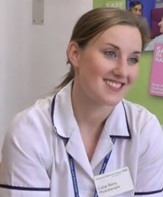Chartered Physiotherapist Lucia Berry treats a number of female teenage patients who experience Stress Urinary Incontinence (SUI), as well as other continence issues. In a guest blog for ERIC, Lucia gives an overview of the continence problems that she works with teenage girls to resolve, and highlights how and when young women should seek support for these issues.
Many people believe that continence problems only occur due to old age or in women who have had babies. However these issues affect many different people, at any age – including teenagers – and for a variety of reasons. You may be surprised to know that even elite gymnasts and runners experience continence difficulties during exercise!1.
When trying to resolve these potentially stressful and embarrassing problems, it’s important to find out what’s causing the symptoms. Not everyone will experience continence issues for the same reason. For example, when looking at bladder continence problems in teenage women, some will find they can’t hold their urine on the way to the toilet and have a desperate urge to pass urine. Therefore, it’s not always possible to treat these symptoms using the same approach.
Pelvic floor exercises in teenage women – when are they necessary?
Every year in England and Wales around 900,000 women give birth to children, including 30,000 teenage women under 182. Women who are pregnant or have had children may develop Stress Urinary Incontinence due to weak pelvic floor muscles, so it’s important to ensure that pelvic floor exercises are done during pregnancy and after having children. It’s often believed that it’s normal to put up with incontinence after having a child, but in the majority of cases things can be resolved through exercising the pelvic floor muscles.
I treat teenage women with incontinence in my hospital clinic, but for teenagers that haven’t been pregnant or had children it is rare that they will have incontinence due to weak pelvic floor muscles. It’s more likely that the pelvic floor muscles of teenagers who have continence problems may be un-coordinated, or be hypertonic (increased tension in the muscles). These issues can equally affect teenage boys.
Ensuring pelvic floor exercises are done correctly
Practising pelvic floor exercises can benefit everyone, but the way it which we exercise these muscles is very important. By practising these exercises the aim is to:
- increase awareness of the muscles
- increase control of these muscles
- increase range of movement of the muscles (how much you can relax and then squeeze)
- increase the strength of the muscles
It’s also important that pelvic floor exercises are done correctly; for example, research suggests that many people do not do the exercises correctly from a leaflet4. If you’ve tried doing pelvic floor exercises and things aren’t improving don’t give up, seek help from a professional who can assess these muscles and help you with your technique.
Some other potential causes of continence problems in teenagers are:
- Hypermobility conditions e.g. Elhers Danlos Syndrome5
- Over active bladder syndrome
- Voiding dysfunction
- Underactive bladder syndrome
- Voiding postponement
- Urinary Tract Infections (UTIs)
- Chronic constipation
When to seek support
In teenagers (female or male) if symptoms of continence problems are frequent and causing embarrassment or stress – and especially if they are severe – then consulting a health professional is important in order to establish the cause and the best solution for reducing symptoms. It’s also likely that there will need to be lifestyle changes such as changing fluid intake and bladder / bowel habits.
If you speak to your GP, they may make a referral on to one of a continence clinic, which can be based in a hospital or in the community. These are run by specialist teams including physiotherapists. You can also self-refer to these clinics rather than going through your GP.
If you want to talk to other girls your age who are going through the same thing, head to ERIC’s Teen Message Boards and share your experience or just read the posts others have left.
If you need any help at all, please give the ERIC helpline a call on 0845 360 8008 or email helpline@eric.org.uk (calls cost 9.6p plus the connection charge).
References:
1 Goldstick O and Constantini N, Urinary incontinence in physically active women and female athletes, April 2013 Br J Sports Med doi:10.1136/bjsports-2012-091880
1Nygaard I, Thompson F, Svengalis S, Albright J, Urinary Incontinence in Elite Nulliparous Athletes, Obstetrics & Gynecology Aug 1994 Vol 84 (2)
2Office for National Statistics data http://www.ons.gov.uk/ons/rel/vsob1/conception-statistics–england-and-wales/2011/sty-conception-estimates-2011.html
4Richard C. Bump, W. Glenn Hurt, J. Andrew Fantl, Jean F. Wyman, Assessment of Kegel pelvic muscle exercise performance after brief verbal instruction American Journal of Obstetrics & Gynecology Volume 165, Issue 2 , Pages 322-329 , August 1991
5McIntosh LJ, Stanitski DF, Mallett VT, Frahm JD, Richardson DA, Evans MI. EhlersDanlos syndrome: relationship between joint hypermobility, urinary incontinence, and pelvic floor prolapse. Gynecol Obstet Invest. 1996;41:135-9.
